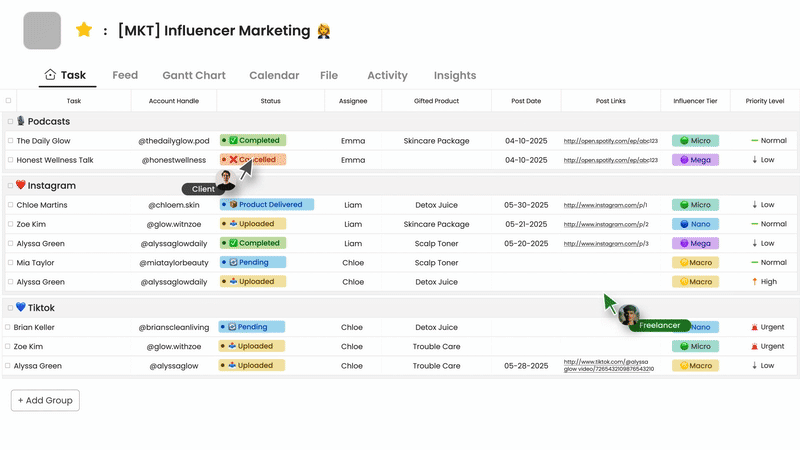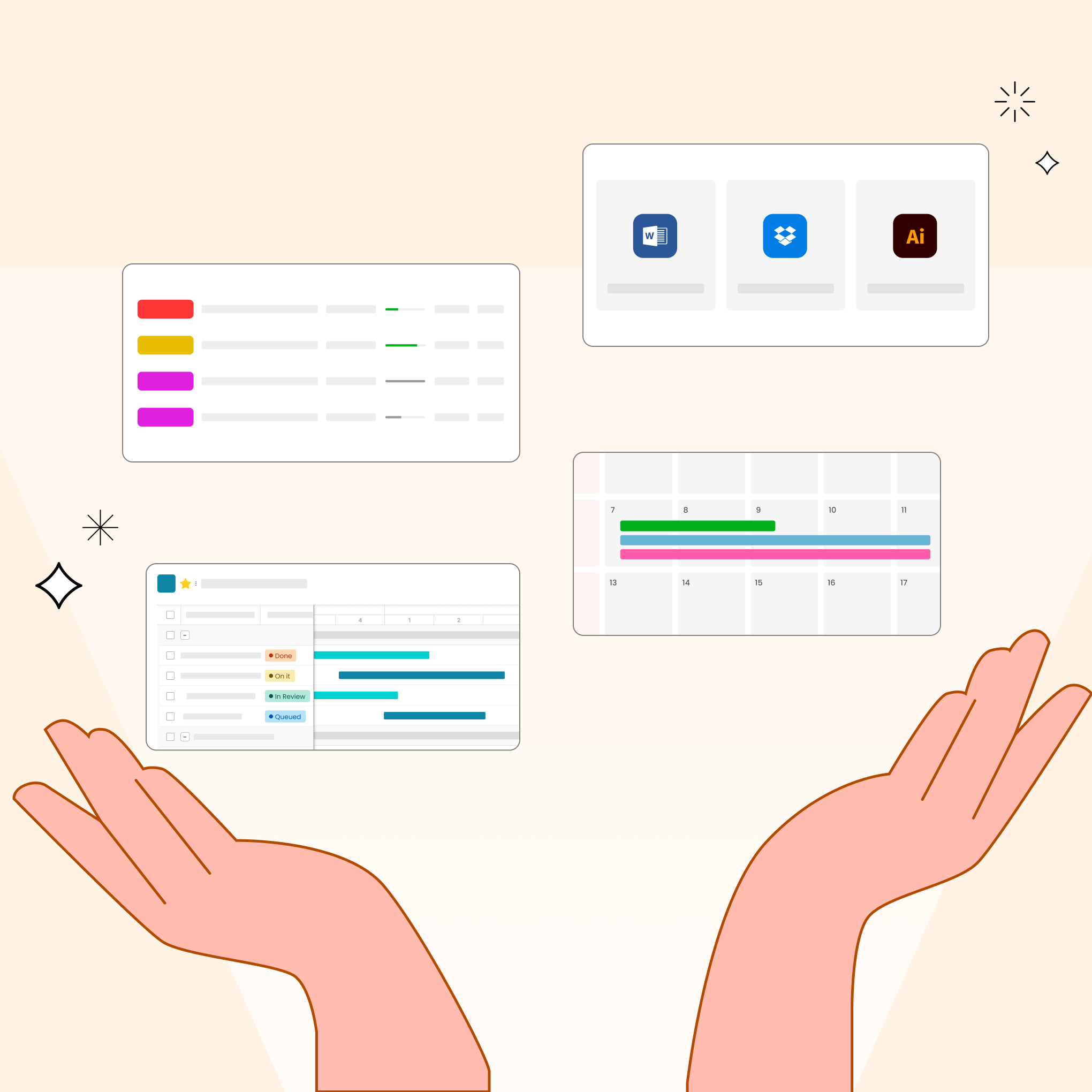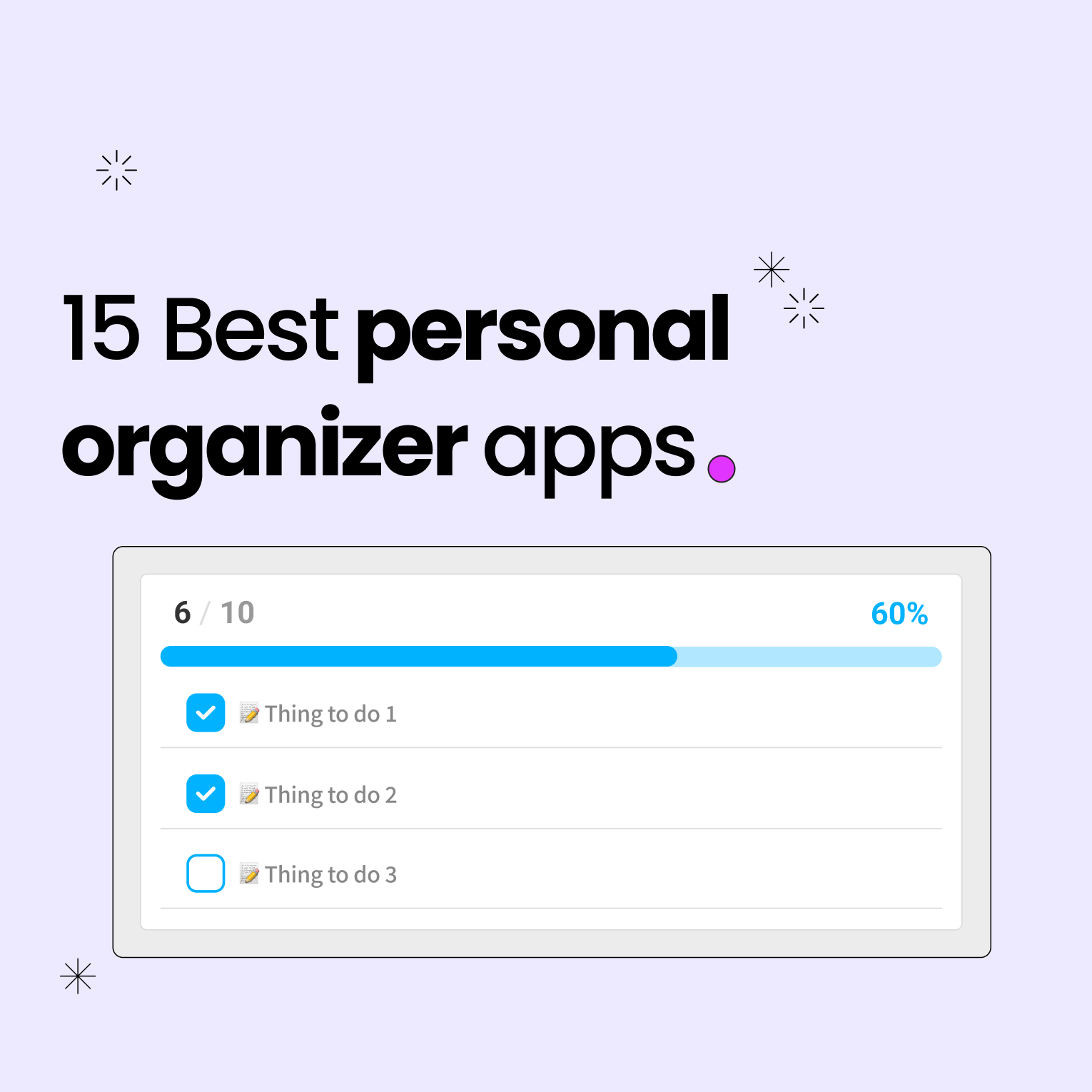Are scattered files, shifting deadlines, and endless feedback comments making it hard for your team to stay organized? Are you also looking for the best creative project management software for a smooth workflow? If so, you are at the right place.
Here, we will share the top 10 project management softwares in 2025 for you. Plus, we will explore what makes these tools game-changers for designers, writers, marketers, video editors, and other users. We will also highlight why they are better than general solutions.
So, are you ready to find the best software to streamline collaboration, boost visibility, and keep your creative team perfectly aligned? Let’s get started!
What Is Creative Project Management Software?
Creative project management software is tailored for how creative teams collaborate—visually, in real time, and with ongoing feedback. Unlike standard project tools, these systems recognize that creativity is non-linear, allowing designers, authors, marketers, and video producers to experiment and revise with instant feedback.
These tools go beyond simple task management, offering features like asset proofing, version control, visual task boards, and integration with platforms like Adobe Creative Cloud and Figma. They facilitate faster collaboration, enabling teams to provide quick input and make adjustments on the fly, ensuring projects stay on track.
The typical creative process involves idea collection, collaboration, client feedback, and final polishing. Without a dedicated system, this can become chaotic, leading to lost files and missed deadlines. Creative project management software integrates communication, assets, and timelines, providing clarity on project status and file locations.
The best tools not only manage work but also enhance creative flow with templates for various projects. They help teams transition from ideas to finished products while allowing managers to identify effective strategies and areas needing adjustment, ultimately supporting the creative process without hindering productivity.
Why Creative Teams Need Specialized PM Tools?
Every project is different, and so is its team. In project management for creatives, you face different challenges than technical or administrative teams. Due to these challenges, creatives need project management tools. Let’s check these out in detail.
Asset Management
In creative workflows, assets like logos, campaign graphics, social media calendars, video files, and presentations constantly evolve. Teams need a centralized place to manage them from initial drafts to final approval. This isn’t something traditional project tools handle well. Creative teams need tools that make version control, proofing, and file sharing seamless.
Feedback Handling
Take feedback, for example. A marketing campaign might go through multiple iterations. Without integrated proofing, designers could juggle feedback from Slack, email, and verbal meetings. This wastes time and introduces errors. But with the right creative project software, comments stay attached to the file. Stakeholders can leave notes directly on a design or video, eliminating confusion.
External Collaboration.
Agencies or internal creative teams collaborate with freelancers, clients, or others. The top-tier creative project management software permits outside users, so clients can log in, see updates, and approve documents without constant email follow-ups. It reduces the feedback loop and builds transparency.
Time Tracking
Time tracking is another must-have. Agencies often bill by the hour. Without time logs tied to tasks and clients, teams lose billable hours or misallocate time. A creative-friendly PM tool lets you track time per task, project, or creative asset.
Integrations
Then there’s the need for integrations. Creative teams use a unique stack: Photoshop, Illustrator, Figma, and Premiere Pro. A good project management tool doesn’t ask creatives to jump between systems. It connects directly to the tools they already use, syncing files, previews, and updates automatically.
Visual Organization
Finally, creative teams need visual organization. Kanban boards, Gantt charts, and calendar views aren’t just productivity hacks—they’re how creatives see the workflow. Being able to drag and drop tasks, color-code workflows, and visualize campaigns in progress keeps the team aligned.
In short, generic project management software lacks the empathy and flexibility that creative work demands. That’s why dedicated tools are no longer a luxury—they’re a necessity.
Key Differences From Traditional Project Management
Creative project management isn’t just project management with pictures. It operates in a different rhythm and has a unique set of challenges. Compared to traditional project management—think IT deployments or construction schedules—creative work is less predictable, more fluid, and often subjective.
- Iteration: First, creative projects thrive on iteration, not rigid timelines. A design might be “done” in a day, then redone three times based on feedback. Traditional PM software tends to work in structured phases, with strict dependencies. That doesn’t reflect how creatives work, where tasks overlap and evolve constantly.
- Visual planning dashboards: Second, creative projects are inherently visual. A plain task list doesn’t show the whole picture. Creative teams benefit from tools that offer visual planning dashboards—Kanban boards, timeline views, and even digital mood boards that map out campaign phases. Seeing progress helps them stay aligned and inspired.
- Feedback loops. Traditional tools might track a bug fix or a status update, but creatives need inline feedback on visuals—annotations, markup, and version comparison. Without these features, feedback gets lost, misinterpreted, or delayed.
- Collaborative conversation: Unlike technical teams, which often use structured communication channels like Jira tickets, creatives rely on collaborative conversation. This means a need for creative workflow tools with built-in chat, comments, and notifications that don’t disrupt workflow.
- File management is another significant gap. In traditional project tools, you might attach a spreadsheet or document. But creatives deal with enormous files—high-resolution photos, video, and multi-layered PSDs—and require software that manages storage, previews, and version tracking. And often, these files have to be proofed, approved, and distributed externally.
- Integration: Traditional project software cannot also integrate with creative platforms. Whether Figma for user interface, Adobe Premiere for video, or InVision for prototypes, innovative teams have specialized software that communicates with the project software.
- Autonomy and flexibility. Overly rigid workflows kill momentum. The best creative PM tools offer customizable templates and dashboards that adapt to the team, not the other way around.
In essence, project management for creatives isn’t about checking boxes—it’s about supporting creative flow while staying on schedule, and that takes a different kind of tool.
Benefits of Using Project Tools for Creatives
Using creative project management tools has multiple benefits. Below, we have listed some of the most important ones to give you an idea of their importance.
Faster Asset Reviews and Approvals
Creative teams manage numerous assets that require extensive feedback, often leading to delays without a formal system. Creative project management software addresses this by offering built-in proofing tools for direct comments on assets, reducing misunderstandings. These tools support multi-round approval workflows, allowing for staged feedback from stakeholders and tracking each step. This approach enhances clarity, centralizes feedback, and minimizes time wasted searching for comments. Additionally, history tracking and version control enable teams to revert to previous edits or designs when needed, streamlining the creative process.
Visual Workflows for Better Clarity
Creative project tracking software enhances visual workflows, which are essential for visual thinkers in creative teams. Unlike traditional project plans, these tools provide Kanban boards, Gantt charts, mood boards, and timelines that clearly display project status. For instance, designers can see color-coded tasks, while marketing managers can easily identify delays in campaigns. Custom dashboards allow teams to organize views based on their specific needs, improving clarity. This visibility is also beneficial for team leads, enabling them to quickly identify bottlenecks, adjust priorities, and reassign tasks without sifting through spreadsheets.
Real-Time Collaboration With Stakeholders
Creative work involves collaboration among designers, copywriters, project managers, clients, and others, whether in-house or at an agency. Real-time collaboration is a key benefit of creative project software, allowing team members to tag each other, leave feedback, and make assignments without switching tools. This centralizes communication, eliminating the need for emails or chat threads. Some tools offer guest access or client portals, enabling external parties to review progress and provide feedback seamlessly. In a fast-paced environment, effective software keeps the team connected in real time, ensuring smooth transitions from ideas to execution without delays.
What to Look for in Creative Project Software?
Picking the right software can be difficult, especially if you don’t know the characteristics you need to look for in it. Here’s what you need to focus on when considering creative project management software:
Feedback and Proofing Features
Feedback is at the heart of creative work. But endless email threads and scattered comments are a recipe for confusion. That’s why project management software for creative teams needs robust proofing features, like inline commenting, markup tools, and version control.
With built-in proofing, reviewers can comment directly on a video frame or a design mockup. It reduces miscommunication and gives designers exactly what they need to revise quickly. Look for software that supports multiple file types—images, PDFs, videos—and lets you track changes across versions.
Approval workflows are also helpful. Some tools let you assign different reviewers in sequence, so you don’t move forward until each round of feedback is complete.
Easy Task and File Management
Creatives often juggle dozens of tasks across multiple projects. Your creative workflow tool should simplify task management, not complicate it. It should have drag-and-drop task boards, due dates, priority markers, and recurring task support.
And don’t forget file management. The best platforms let you attach files directly to tasks, so assets are easy to find. Some tools even support cloud integrations (like Google Drive or Dropbox), and offer preview options so you don’t have to download files to view them.
Ideally, your creative project software should keep tasks and files in context—no more guessing which design matches which brief.
Integrations With Design Platforms (Adobe, Figma, etc.)
Creative teams rely on a different stack than most departments. That’s why your project tool needs to support seamless integration with design systems such as Adobe Creative Cloud, Figma, Sketch, Canva, or InVision. They reduce friction and save time.
These integrations save time and reduce friction. For example, instead of uploading a file to another system, you can sync it directly from Figma. Some tools update file previews automatically when you make changes, so your team always sees the latest version.
Bonus points if your platform integrates with Slack or Microsoft Teams for notifications, or with time-tracking tools for billing and budgeting.
Visual Planning Dashboards and Templates
The best creative workflow tools aren’t just functional—they’re visually intuitive. Dashboards that show work by campaign, deadline, or department help everyone understand priorities at a glance.
Templates are also key. Whether it’s a content calendar, campaign rollout, or client onboarding flow, pre-built templates save time and help standardize your processes. Look for software that offers ready-to-use templates or lets you create custom ones for repeatable workflows.
In short, your project management software should feel like a creative ally, not just a digital checklist.
Best Creative Project Management Software 2025 List
The correct choice of creative project management software can mean the difference between a disorganized production process and a smoothly run creative process.
For designers, marketers, video editors, content planners, and agencies, a good tool should provide more than mere task tracking—it should enable visual workflows, collaborative feedback, file versioning, and effortless communications among all involved parties.
Here’s a list of the top 10 in 2025 for handling creative work regarding industry, usability, and real-world practicality. Let’s check these out one by one.
1. Morningmate

Morningmate is built for creative teams who think visually and work collaboratively. It’s not just another dashboard—it’s a complete workspace where ideas are shared, projects stay visible, and everyone moves in sync. Designers, marketers, and content producers will appreciate how easy it is to keep work organized and communication effortless.
Unlike rigid tools, Morningmate adapts to how creative teams think. The layout feels familiar, with feeds, chat threads, and customizable dashboards that keep your most-used tools front and center. You’re not locked into one view—you can switch between Kanban, calendar, and conversation-style feeds depending on the nature of your work.
Creative professionals often deal with moving parts: shifting deadlines, client input, and last-minute changes. Morningmate helps simplify that chaos. It reduces meetings, cuts down on email, and makes room for actual creative output by bringing everything—tasks, updates, comments, files, and feedback—into one platform.
Following are some of the key features of Morningmate:
- Assign tasks, deadlines, and priority levels so everyone knows their role.
- Pin checklists to the top of the feed to keep the team aligned.
- Customize dashboards with tools and information your team uses most.
- Use comments and chat to give feedback directly on updates or changes.
- Invite clients to a dedicated workspace with a simple link—no logins or training needed.
- Track campaign progress and wrap-ups using AI-powered summaries and performance comparisons.
- Celebrate deliverables with event posts and in-platform reactions like likes, DMs, or fun stickers.
- Store and locate files easily with universal search and comprehensive file lists.
Whether you’re managing a video production schedule, rolling out a new brand identity, or organizing a product launch, Morningmate brings creative people together in a workspace that actually supports the way they work.
For teams tired of juggling apps and scattered communication, Morningmate is the best creative project management software to get organized, get feedback fast, and bring ideas to life.
2. ClickUp
The second on our creative project management tools list is ClickUp. It is very popular due to the high level of customization it offers. It provides growing creative teams who want complete control over their workflows. From campaign planning to content production and UI design, ClickUp can be shaped to fit nearly any creative process.
The platform supports multiple project views—Kanban, list, Gantt, timeline, calendar, and mind maps. It allows teams to work how they want. Teams can create spaces and folders by client or campaign, organize design phases, and track status changes with automation rules.
For creative work, ClickUp offers proofing features where users can annotate PDFs and image files. Team members can leave comments on specific areas of a design, turning vague emails into pinpointed, visual feedback. It also includes custom request forms, perfect for agencies collecting briefs or internal design teams managing asset requests.
ClickUp Docs is another strength. It allows marketers and content teams to draft campaigns, tag collaborators, and embed creative elements directly into the workflow. There’s even a whiteboarding feature to brainstorm ideas or plot design ideas.
Although ClickUp’s learning curve is high, its features—including the ability to create dashboards, determine project objectives, and configure automated review flows—make it perfect for big teams requiring depth, structure, and scale.
3. Asana
Content teams and managers prefer Asana, which has an uncluttered interface and a robust balance between functionality and simplicity. It’s less convoluted than ClickUp but doesn’t sacrifice essential features that help creative teams accomplish things.
With Kanban, timeline, or calendar views, creatives can map out campaigns or production timelines. Task dependencies and subtasks allow for assigning designing tasks to the correct individual at the proper moment with minimal bottlenecks.
What really stands out about this creative project tracking software is its creative request workflows. With customizable intake forms, teams can gather all the needed details—copy tone, design specs, audience focus—upfront. These requests convert automatically into tasks, streamlining the intake-to-delivery process.
Teams can also add files, tag teammates, and have threaded discussions directly in each task. Although Asana doesn’t have native proofing for creative assets, it integrates nicely with Figma, Adobe Creative Cloud, Loom, and Frame.io so that teams can collaborate smoothly with their current tools.
Its strong reporting and workload functionalities assist managers in balancing resources and accurately projecting project schedules. It is excellent for agencies with multiple deadline expectations or internal teams coordinating multi-phase launches.
4. Monday.com
Monday.com is a flexible platform that specializes in visual task management. Its interface features colored status bars and dynamic boards that give creative teams instant clarity on what’s in motion, pending, and completed.
Any task assigned for Monday can have detailed descriptions, file uploads, status indicators, and due dates. But what’s great about it for creatives is that it allows you to create project templates for repetitive workflows, such as blog post calendars, email marketing pipelines, or brand video production cycles.
It also features a visual proofing tool allowing users to comment and mark up media files. When assets need feedback from multiple departments or external partners, this saves time and keeps the discussion visible.
Creative managers can also customize columns in their boards, tracking campaign goals, creative briefs, asset types, and feedback rounds in one place. With its support for table, calendar, Gantt, or Kanban views, Monday.com becomes highly versatile for any working style.
One such highlight is the platform’s automation feature, which enables teams to create recurring tasks, deadline reminders, or approval chains. For creatives who have to deal with volume and velocity, automation cuts down manual overhead while enhancing consistency.
5. Wrike
Wrike is a powerful project management software for creative teams. It is mostly used by high-complexity creative departments, particularly marketing or branding teams. It has a more organized interface than MorningMate or Trello, but offers capabilities necessary for teams working on many deliverables to multiple stakeholders.
Its standout feature for creatives is Wrike Proof. With this tool, teams can upload files—PDFs, images, video drafts—and reviewers can comment directly on visual elements. This minimizes ambiguity and supports faster turnarounds.
Wrike also offers dynamic request forms, which convert submissions into tasks and assign them to the proper workflow. For agencies or in-house design teams that get frequent requests from sales, product, or external clients, this centralized intake system saves hours of administrative work.
Creative teams also benefit from Wrike’s resource planning tools. Managers can check bandwidth, reassign tasks based on capacity, and prevent overbooking. With real-time dashboards and reporting, Wrike becomes a full-service solution for creative operations.
With over 400 integrations—including Adobe Creative Cloud, Slack, Dropbox, and Microsoft Teams—Wrike doesn’t require creatives to switch tools. Instead, it brings their existing ecosystem into one centralized command center.
6. Trello
Trell is also among the very popular creative project management tools. Trello’s strength is its simplicity and visuality. It employs a card-based Kanban layout for smaller-scale creative teams or freelancers with design sprint, content pipeline, or brand asset management needs.
The project, client, or workflow stage can be set up for each board. You can add checklists, uploads, comments, due dates, and labels within each card. It’s very user-friendly, making it quick to add new team members.
For creatives, however, Trello becomes a digital whiteboard, where images can be organized, feedback can be monitored, and campaign stages can be mapped out without an elaborate setup. The integration can, however, extend to other tools such as Figma, InVision, Loom, or Google Drive through Power-Ups.
Although Trello lacks native proof or reporting functionality, it compensates with its visual hierarchy, drag-and-drop ease, and low cost. It’s a go-to choice for designers and writers who want less admin and more creativity.
7. Notion
Notion offers a blend of wiki, task management, and creative workspace. While it’s not built specifically for project management, many creative teams have embraced it as a customizable, central brain for their workflows.
You can create databases for blog calendars, mood boards, campaign plans, and client deliverables. Use gallery views to organize design assets, or timeline views to map production deadlines.
Notion allows full content embedding—images, videos, Figma files, and Google Docs—and supports inline comments, making collaboration clean and easy. It’s especially popular among remote content teams and startup agencies that want flexibility over formality.
Although this creative project tracking software lacks certain features, such as tracking resources or proof, its integration of notes, tasks, and visualizations into a unified experience makes it great for planning, ideation, and implementation in a single location.
8. Basecamp
Basecamp is a collaboration-first tool for teams that need less structure and more conversation. It’s great for creative teams that want frequent check-ins and written feedback, not status meetings and formal reports.
Every project features a built-in message board, to-do list, file library, calendar, and group chat.. It creates a clear division between teams and keeps conversations focused.
For creatives, Basecamp is particularly helpful for:
- Centralizing feedback threads
- Keeping asset versions organized
- Avoiding the “where’s that file?” problem
It is one of the best creative workflow tools. It’s simple, but for teams focused on client communication and deliverable tracking, Basecamp offers clarity without the bloat of enterprise tools.
9. Teamwork.com
Teamwork is built specifically for agencies managing client projects. It supports the creative delivery process—from project scoping and resourcing to time tracking and invoicing.
Creative teams benefit from:
- Dedicated client access portals
- Built-in proofing and file sharing
- Custom templates for repeatable workflows
- Time and cost estimates for each task or campaign
Teamwork bridges the gap between execution and business, helping agencies meet deadlines while tracking profitability. It also integrates well with billing tools, Adobe apps, and CRM systems.
10. Adobe Workfront
The last on our list of creative project software is Adobe Workfront. It is an enterprise-grade platform deeply integrated with Adobe Creative Cloud, making it a natural choice for large marketing departments, agencies, and media teams.
What creatives get:
- In-app integration with Photoshop, Illustrator, Premiere, and more
- Detailed proofing, version control, and approval workflows
- Automated intake forms and project templates
- Dashboards for workload, performance, and campaign health
It’s built for scale, managing hundreds of requests, complex production timelines, and multiple reviewers. Creative directors can monitor progress across brands or departments, while designers stay focused on the Adobe tools they use daily.
Workfront may be overkill for smaller teams, but it delivers unmatched power and integration for companies producing a high volume of branded content.
Why Creative Teams Choose Morningmate?
When your team works on campaign visuals, multi-phase branding, products, or any other such project, you need more than a task list. You need a space where people can collaborate naturally, share feedback without chaos, and stay focused through every stage of the project.
That’s why creative teams are switching to Morningmate, the best creative project management software for teams that move fast and work visually.
Here’s what makes it stand out:
- Organize your team’s workspace by project, campaign, or client.
- Collaborate without friction using real-time chat, feed comments, and direct feedback tools.
- Cut out unnecessary steps with pinned checklists, quick assignments, and shared dashboards.
- Share progress with clients using simple links—no logins or setup headaches.
- Celebrate final deliveries with team event posts, reactions, and project highlight summaries.
Whether you’re launching a campaign or finalizing a design sprint, Morningmate clears the clutter so your team can focus on what they do best—creating. Try Morningmate today for free and give your creative project the clarity it deserves.




